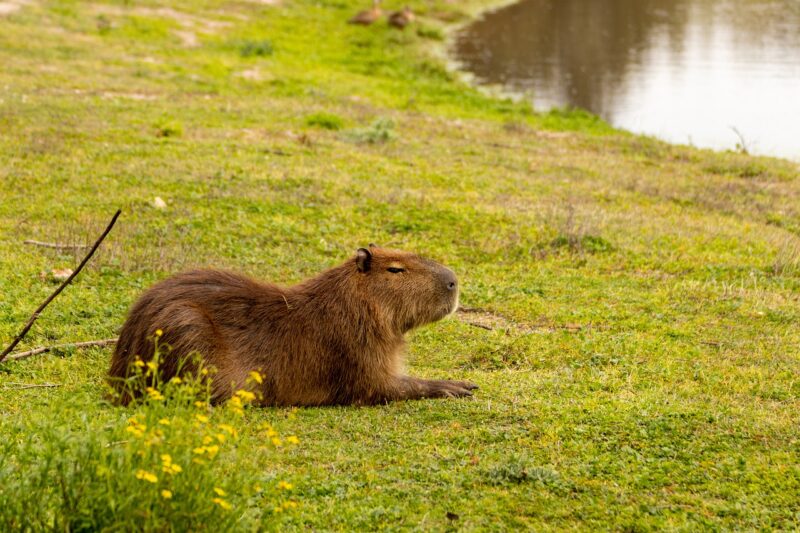Meet the Capybara: Why This Giant, Friendly Rodent Is Becoming a Popular and Unusual Pet
November 13, 2024

The capybara, often dubbed as the world’s largest rodent, is becoming a favored choice for those looking for an unconventional pet. Known for their friendly dispositions and social nature, these gentle giants are often seen lounging by the water’s edge or socializing in groups. In this article, we will delve into the fascinating world of capybaras, exploring their origins, behavior, care requirements, and why they might be the perfect pet for some.
1. What Is a Capybara?
Capybaras (Hydrochoerus hydrochaeris) are native to South America, primarily found in countries like Brazil, Venezuela, and Colombia. These semi-aquatic mammals are closely related to guinea pigs and chinchillas, despite their much larger size. Adult capybaras typically weigh between 77 to 150 pounds and can grow up to 4 feet in length.
They have a distinctive appearance with a large, barrel-shaped body, short legs, and a slightly rounded snout. Their fur is coarse and brownish in color, allowing them to blend into their natural habitat of rivers, marshes, and dense forests.
2. Natural Habitat and Behavior
Capybaras thrive in tropical and subtropical regions, often found near bodies of water. They are social creatures that live in groups often comprising 10 to 20 individuals, although larger groups can form in ideal environments.
These rodents display fascinating behaviors:
- Social Creatures: Capybaras form strong social bonds within their groups, regularly engaging in grooming and cuddling behaviors to strengthen their connections.
- Communication: They communicate through a variety of sounds, including barks, whistles, and purrs, which inform the group about potential dangers or changes in their environment.
- Semi-Aquatic Lifestyle: Capybaras are excellent swimmers, and they often take to the water to cool off, escape predators, and even sleep submerged, with only their noses above the surface.
Adjusting to the life of a capybara requires an understanding of their need for socialization and space to roam, much like dogs or large domesticated animals.
3. Capybaras as Pets: What You Need to Know
While capybaras can be wonderful companions, there are a few crucial considerations before jumping into ownership. Here’s a comprehensive outline of what prospective owners should keep in mind:
A. Legal Considerations
Ownership laws for capybaras differ depending on the region. In some areas, they are considered exotic pets and require special permits to own. Be sure to verify local regulations before acquiring one.
B. Space Requirements
Capybaras need plenty of space to roam. An ideal setup includes:
- A large outdoor enclosure with a secure fence.
- Access to a pool or pond for swimming.
- Room for them to graze and play—remember, capybaras are herbivores!
C. Social Needs
Because of their deeply social nature, capybaras do best when kept in pairs or small groups. If you only plan on having one, be prepared to invest significant time to interact with them, as solitary capybaras can become lonely and stressed.
D. Diet
Capybaras are herbivores, primarily eating grass and aquatic plants. A balanced diet may include:
- High-quality hay.
- Fresh fruits and vegetables (in moderation).
- Commercial pellets made for capybaras or large rodents.
Maintaining a proper diet is essential for their health and wellbeing.
4. Pros and Cons of Owning a Capybara
Every pet comes with its set of advantages and challenges. Here are the pros and cons of capybara ownership:
Pros:
- Gentle Nature: Capybaras tend to be calm and friendly, making them easy to interact with and handle, especially if socialized early on.
- Unique Companion: Owning a capybara can be a conversation starter and a unique experience compared to more traditional pets.
- Social Animals: They can bond well with humans and other pets and bring joy through their sociable behavior.
Cons:
- Special Care Requirements: Their need for large enclosures and social interaction might not suit every lifestyle.
- Potential Aggression: Like any animal, capybaras can have aggressive tendencies, especially if not socialized properly or feeling threatened.
- Exotic Pet Status: They can require permits and specific care knowledge not typical among standard domestic pets.
Considering these pros and cons is vital before adding a capybara to your family.
5. The Growing Popularity of Capybaras
Capybaras are increasingly becoming popular pets, fueled by social media, where videos and pictures of these adorable creatures have captured the hearts of many. The hashtag #Capybara has millions of posts, showcasing these friendly rodents in various entertaining situations.
This growing fascination has also influenced the demand for capybara ownership. While they may not be suited for everyone, for those with the right environment and dedication, they can be an incredibly rewarding pet.
As they become more established in pop culture, foster care networks, and specialized breeders are stepping up to meet the needs of potential capybara owners with proper education and resources.
Conclusion
The capybara is an extraordinary pet choice for those who can offer them the environment and companionship they require. With their gentle demeanor, social nature, and unique personality, capybaras can form deep connections with their owners, bringing a remarkable experience to those who choose to welcome them into their lives. If you’re considering adopting a capybara, be sure to do your research and ensure that you can provide a fulfilling and nurturing environment—after all, these delightful giants deserve the best!







